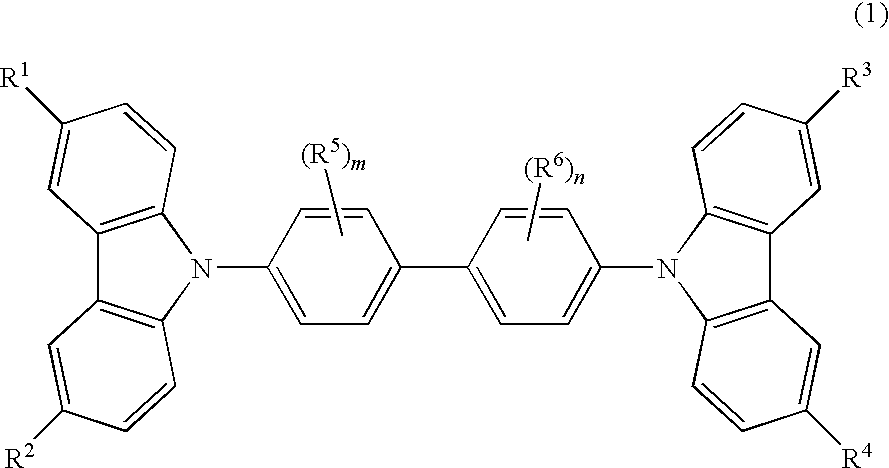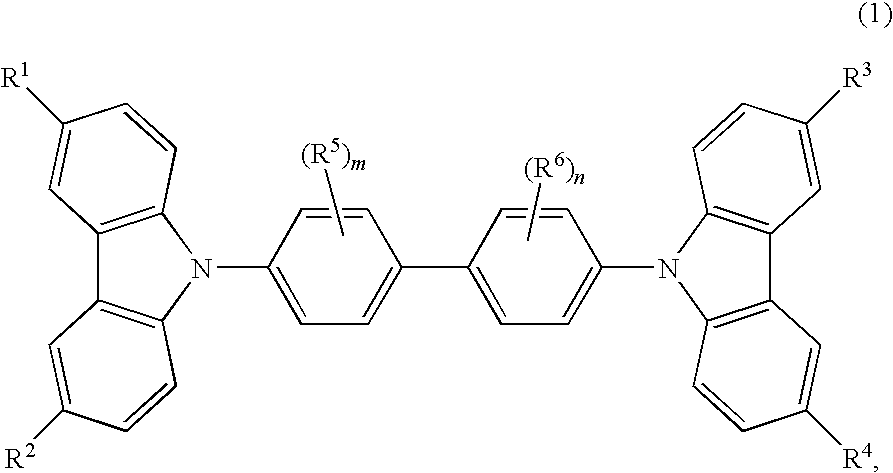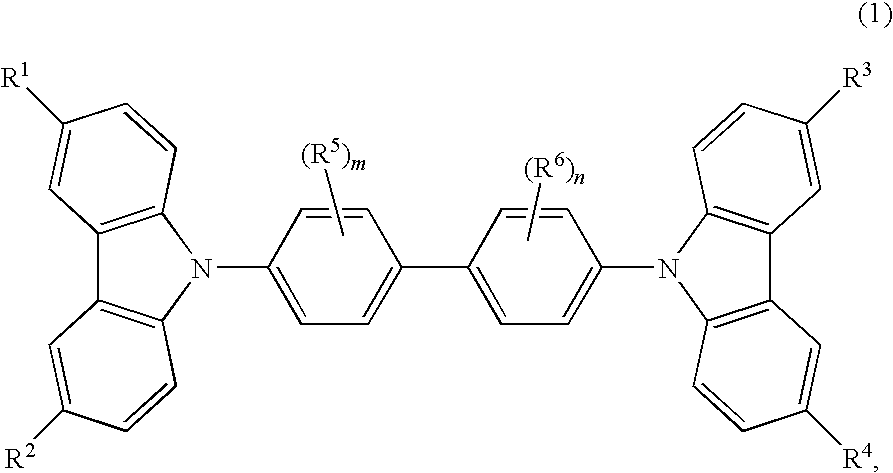Cbp compound
- Summary
- Abstract
- Description
- Claims
- Application Information
AI Technical Summary
Benefits of technology
Problems solved by technology
Method used
Image
Examples
synthesis example 1
Synthesis of Polymer Compound 1
[0055]1.72 g of triscaprylylmethylammonium chloride (manufactured by Sigma-Aldrich Co., trade name: Aliquat 336), 6.2171 g of Compound A represented by the following formula:
0.5085 g of Compound B represented by the following formula:
6.2225 g of Compound C represented by the following formula:
and 0.5487 g of Compound D represented by the following formula:
were placed in a 500-ml four-necked flask and the air inside the flask was replaced by nitrogen. Then, 100 ml of toluene was added, and 7.6 mg of dichlorobis(triphenylphosphine)palladium(II) and 24 ml of a sodium carbonate aqueous solution were added thereto. After stirring for 3 hours under reflux, 0.40 g of phenyl boric acid was added, and the mixture was stirred overnight. A sodium N,N-diethyldithiocarbamate aqueous solution was added, and then the mixture was stirred under reflux for 3 hours. Phases of the obtained reaction liquid were separated from each other. The organic phase was washed with a...
synthesis example 2
Synthesis of Polymer Compound 2
[0056]40.18 g of triscaprylylmethylammonium chloride (manufactured by Sigma-Aldrich Co., trade name: Aliquat 336), 234.06 g of Compound A represented by the following formula:
172.06 g of Compound E represented by the following formula:
and 28.5528 g of Compound F represented by the following formula:
were placed in a 5-L separable flask and the air inside the flask was replaced by nitrogen. Then, 2620 g of argon bubbled toluene was added thereto. With stirring, additional 30-minute bubbling was performed. Thereafter, 99.1 mg of palladium acetate and 937.0 mg of tris(o-tolyl)phosphine were added, which were then washed with 158 g of toluene. The mixture was heated to 95° C. After dropwise addition of 855 g of a 17.5% by weight sodium carbonate aqueous solution, the bath temperature was raised to 110° C., and the mixture was stirred for 9.5 hours. Thereafter, 5.39 g of phenyl boric acid dissolved in 96 ml of toluene were added thereto, and the mixture was ...
example 1
Synthesis of Charge Transporting Compound H
[0058]1.63 g (3.0 mmol) of Compound G (purchased from Tokyo Chemical Industry Co., Ltd.) represented by the following formula:
and 16.3 g of N,N-dimethylformamide were stirred in a flask. Then, 0.24 g (6.0 mmol) of sodium hydride (60% oil dispersion) was added, and the mixture was stirred for 30 minutes. Then 0.82 g (6.0 mmol) of n-butyl bromide was added thereto, and the mixture was stirred for 18 hours. Thereafter, the obtained reaction liquid was poured into 100 ml of water. Extraction was performed twice with 100 ml of chloroform, and the oil layer was washed twice with 100 ml of water. After the oil layer was concentrated by using an evaporator, the residue was purified by silica gel chromatography (eluent was chloroform:hexane=1:1 (volume ratio)). Thus, 1.70 g (Yield: 94.4%) of Charge Transporting Compound H represented by the following formula:
was obtained.
[0059]1H-NMR (270 MHz, CDCl3):
[0060]δ 0.93 (t, 3H), 1.43 (m, 2H), 1.59 (m, 2H),...
PUM
 Login to View More
Login to View More Abstract
Description
Claims
Application Information
 Login to View More
Login to View More - R&D
- Intellectual Property
- Life Sciences
- Materials
- Tech Scout
- Unparalleled Data Quality
- Higher Quality Content
- 60% Fewer Hallucinations
Browse by: Latest US Patents, China's latest patents, Technical Efficacy Thesaurus, Application Domain, Technology Topic, Popular Technical Reports.
© 2025 PatSnap. All rights reserved.Legal|Privacy policy|Modern Slavery Act Transparency Statement|Sitemap|About US| Contact US: help@patsnap.com



